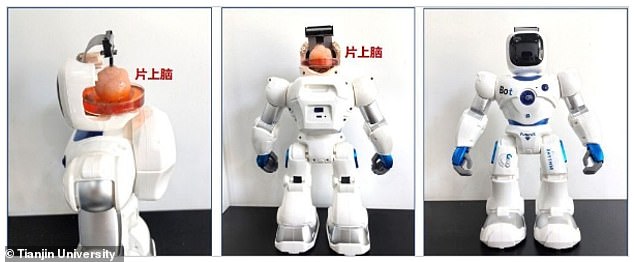Chinese scientists have created a Frankenstein-like robot that runs on a tiny human brain, a first-of-its-kind feat.
The new system included a lab-grown brain organoid, a mass of cells, and a computer chip that interacts with the brain’s nervous system.
The chip was designed with sensors and an AI-powered algorithm that Encourage the robot to move, grab objects and avoid obstacles.
The team reported that the brain exhibits signs of intelligence, similar to the human brain, and could lead to methods to repair damage to a human’s cerebral cortex and create other techniques to cure neurological disorders.
A team of Chinese scientists used stem cells to build the brain and paired it with a computer chip that passes instructions to the robot’s body that helps it move its limbs, avoid obstacles and track targets.
Scientists at Tianjin University created the machine using a branch of brain-computer interfaces (BCI) that combine electrical signals released by the brain with external computing.
This interface is the same one used to create Elon Musk’s Neuralink chip, which was implanted in the brain of a human patient, allowing him to control a computer with his mind.
Neuralink’s device works with a custom chip inside the implant that processes signals and transmits them via a standard Bluetooth connection.
However, the Chinese researchers have not shared how they transmit signals to their organoid.
To create their “living machine,” the team used pluripotent stem cells (a type of cell that exists in early embryonic development) to form the organoids that divided into different types of cells found in the brain, including tissue, said Ming Dong, senior author of the study.
Organoids are small, self-organizing three-dimensional tissue cultures made from stem cells.
These cultures can be engineered to replicate much of the complexity of an organ or to express selected aspects of it, such as producing only certain cell types.
Scientists take the stem cells and grow them for about a month until they form neuron-like features.
However, the Chinese scientists have not revealed how they trained the organoid to know when the robot should perform specific tasks.
The team said the technology still faces “bottlenecks such as low developmental maturity and insufficient supply of nutrients,” which typically include antioxidants, fiber and minerals.
When the organoids were grafted into the brain, they established a functional connection when treated with low-intensity ultrasound, which helped them form neurons that send messages from the brain creating voluntary and involuntary movements.
Low-intensity ultrasound stimulation uses a transducer to directly transfer acoustic energy to the organoid to regenerate biological tissues.
The researchers explained that the robot has no eyes and only responds through electrical and sensory signals sent by neurons.
The team clarified that the pink spot above the robot’s shoulders in the images is just a cosmetic representation of what the brain will look like, not the actual tissue still being used in prototypes.
“Brain organoid transplants are considered a promising strategy to restore brain function by replacing lost neurons and rebuilding neural circuits,” the study said, according to the The South China Morning Post.
However, the research is still in the early stages of development and it is not yet clear whether organoids could ever be used to repair or rebuild damaged brain tissue.

Experts made special perforations in the face of a robot, which helped a layer of skin to adhere
This comes days after scientists in Japan grafted human skin tissue and ligament structures onto the face of a robot to display human-like emotions.
Scientists from the University of Tokyo published a video showing a strange smiling robotic face created from lab-grown human skin.
According to the team, robots with real skin not only have an “increasingly realistic appearance,” but could also heal themselves if they are damaged.

